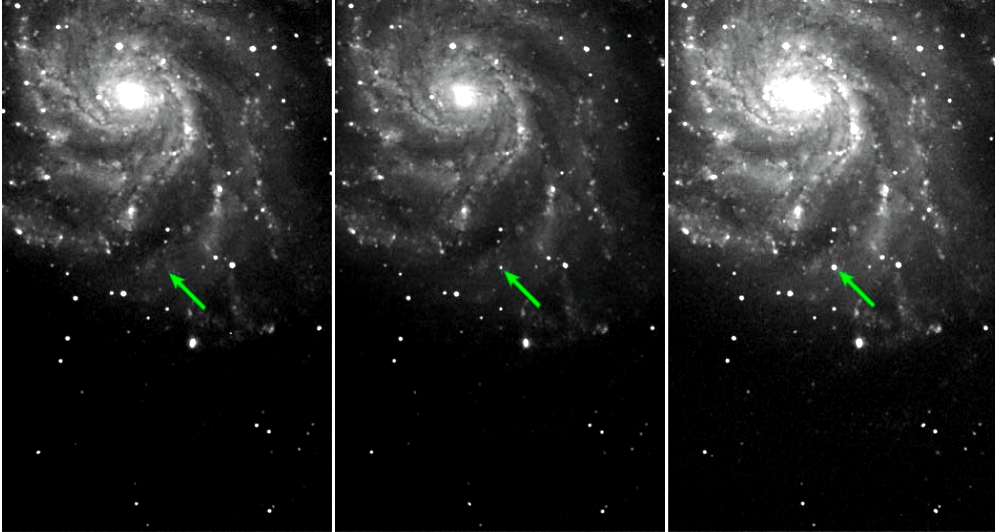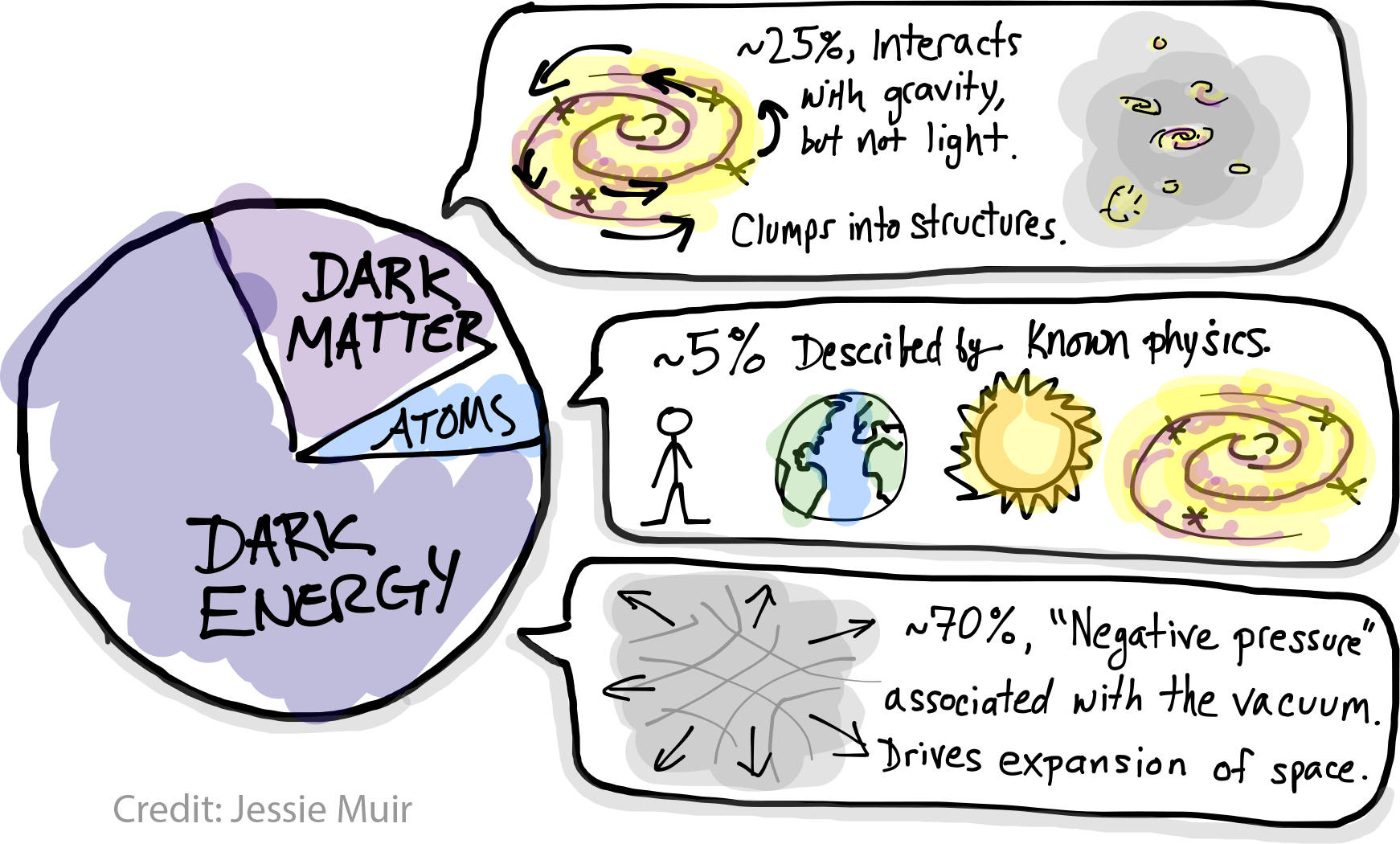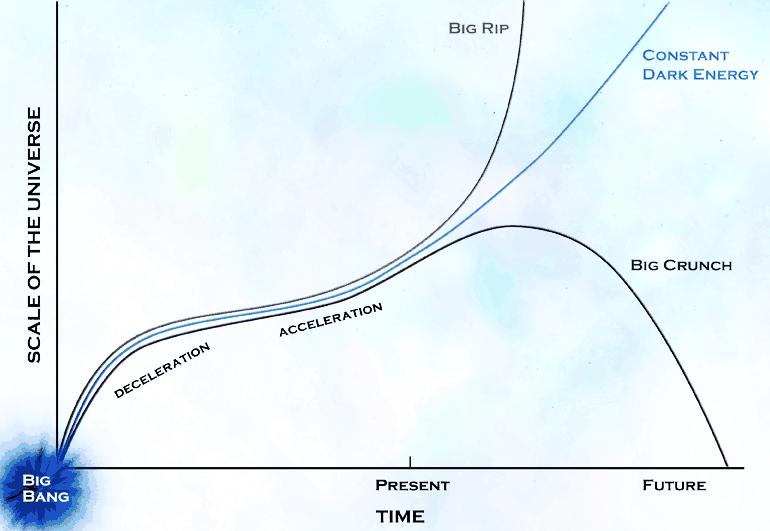The Universe is Growing Larger in Size and No One Knows Why. There Are a Few Guesses Though. #darkenergy #unsolvedproblems
Dark Energy
The backdrop of the topic of dark energy was covered in a previous post. Here we continue on with the tale of the expanding universe.
Hubble discovered that the universe is expanding. Is that rate of expansion constant? No. It turns out the expansion of the universe is actually accelerating.
An accelerating expanding
universe
We have discussed
‘standard candles’ before. Hubble used Cepheid variables to observe the
distances to distant galaxies, and hence deduce his eponymous law. It would
take observations of another kind of standard candle—the Type Ia Supernovae—to
infer the accelerating expanding nature of the universe.
 |
| The large-scale structure of the universe. The Cosmological Principle dictates that the Universe is isotropic and homogeneous on the largest scales. Credit: Sky Lights |
 |
| Type Ia supernova from an accreting white dwarf Credit: Make A Gif |
In 1998, two independent
research projects, the Supernova Cosmology Project and the High-Z Supernova
Search Team, used distant Type Ia supernova to measure the accelerating
expansion of the universe.
 |
| The Supernova Cosmology Project team, 2011 Credit: Colorado College |
 |
| High-Z Supernova Search Team at the Nobel ceremony with Nobel awardees Brian Schmidt and Adam Riess Credit: University of Notre Dame |
What is a Type Ia
supernova, you ask? Supernovae are death throes of stars. High mass stars at
the end of their lives, having consumed all their fuel (by fusing Hydrogen into
Helium, Helium into Carbon, Carbon into Magnesium and so forth) die in violent
cataclysmic deaths by exploding outwards. Type Ia is a specific subtype of
supernova-- it is a type of supernova that occurs in binary systems (two stars
orbiting one another) in which one of the stars is a white dwarf. The other
star can be anything from a giant star to an even smaller white dwarf. The
supernova occurs when the white dwarf siphons off matter from the star and
exceeds the critical mass of 1.4 solar masses (known as the Chandrasekhar
limit) and explodes in a supernova.
 |
Type Ia supernova in a galaxy Credit: PE Nugent et al. Nature 480, >> 344-347 (2011) doi:10.1038/nature10644 |
 |
| Three distant Type Ia supernova observed by the Hubble space telescope in 1997 Credit: P. Garnavich (Harvard-Smithsonian Center for Astrophysics) and NASA |
All observations seem to
indicate that Type Ia supernovae that are of known distance have the same
brightness, corrected by the shape of the light curve. This enables them to
serve as standard candles. Type Ia supernovae have constant luminosity, which
means that they can be used as accurate distance measures. Comparing this
distance to the redshift (which measures the speed at which the supernova is
receding) shows that the universe's expansion is accelerating.
In 2011, Saul Perlmutter,
Brian P. Schmidt and Adam G. Riess were awarded the Nobel Prize in Physics "for
the discovery of the accelerating expansion of the Universe through
observations of distant supernovae".
What mechanism could drive this accelerating expansion?
This is very
counterintuitive—to say the least. The energy associated with this unseen
anti-gravity must be present have a fixed density throughout space, and oppose
gravitational attraction on the largest scales. How is this possible?
Not only does this
“unseen force” permeating spacetime seem rather outlandish, it also breaks the
law of conservation of energy in the way we usually think about it. After all,
if the energy density of dark energy remains constant while space expands and
its volume increases, surely the total amount of dark energy must be
increasing. A common analogy used to explain this is throwing a ball in the
air, and instead of it slowing down, stopping and coming back to you, you watch
it fly away faster and faster, escaping Earth’s gravitational pull.
Dark energy thankfully
doesn’t break such a fundamental law of nature outright, though. In general
relativity, the local conservation of all energy densities is the relevant
conservation law-- a law fulfilled by dark energy.
That addressed, where
does this energy come from? What is the mechanism behind dark energy, so to
speak?
There are no definite answers to these questions, and they remain some of the biggest unanswered questions in cosmology and astronomy to date. There are numerous proposed explanations, including ‘vacuum energy’, modified gravity and ‘quintessence’. Scientists today may not know what dark energy is, but they have deduced some of its properties and characteristics, as well as a few possible explanations.
Dark Energy: What Is It?
The fascinating term 'dark energy' was coined by UChicago astrophysicist Michael Turner in 1998, as a reference to the equally famous 'dark matter', which has captured the public imagination as much as dark energy in the recent decades. The two don't seem to share any other direct association apart from their name, however.
Using the cosmological
principle (which asserts that the universe is homogeneous and isotropic on the
largest scales), and the best cosmological model of the universe-- ΛCDM--
scientists have ascertained that this elusive ‘dark energy’ comprises as much as
68% of the universe’s total energy. Our other elusive friend ‘dark matter’
comprises a little over a quarter (26% to be precise), which leaves only 6% for
all the ‘regular’ matter and energy we have directly observed and have
knowledge of—this includes ordinary or baryonic matter, photons and neutrinos.
 |
| Energy budget of the universe Credit: Jessie Muir, own work |
So, here is a rundown of
the leading explanations for dark energy.
Leading Theories Explaining the Existence of Dark Energy
The first one of them is
our old friend, the cosmological constant—Einstein’s biggest blunder might turn
out to have been a great, unexpected insight after all.
Einstein’s Biggest Blunder or an Unexpected Insight?
The introduction of the
cosmological constant may not have been as big of a blunder as Einstein
originally conceived it to be—indeed, today it constitutes the simplest
explanation for dark energy.
After the discovery of
the accelerating expansion of the universe, the concept of the cosmological
constant was revived. It became the term representing the energy density of
space, or ‘vacuum energy’ that permeates spacetime. Consider vacuum energy to be
the minimum possible energy possessed by empty spacetime—a type of zero-point
energy. This would mean that the cosmological constant would assume a positive
value for an accelerating expanding universe.
| Einstein's field equation Credit: University of Oregon |
The cosmological constant
forms part of the best model of the universe today, the ‘standard model of
cosmology’, if you will. It is the Lambda-CDM or Lambda cold dark matter model,
abbreviated as ΛCDM. We shall delve into this model next time, and explore some
of the implications of this model and its future, along with the Hubble
tension, more colloquially referred to as the “Crisis in Cosmology”.
Modified Gravity
The entire existence of
dark energy is hinged on the theory of general relativity. The question in many
scientists’ heads was: “What if gravity itself is modified on the larger scales
so as to eliminate the problem of dark energy?”. Thus, modified gravity was
born.
There are many such
theories, and research is ongoing. Some of these theories combine dark matter
and dark energy into one substance, essentially stating that dark energy and
dark matter might just be two sides of the same coin.
However, it is worth
noting that the measurement of the speed of gravity in the first gravitational
wave measured by non-gravitational means (GW170817) ruled out many modified
gravity theories as explanations to dark energy.
Quintessence
According to Wikipedia,
“In quintessence models of dark energy, the observed acceleration of the scale
factor is caused by the potential energy of a dynamical field, referred to as
quintessence field.”
Quintessence is a form of
dark energy. It is a scalar field (a region of space that can be assigned numerical
values) that unlike the cosmological constant, can vary with space and time.
Dark Energy and the Ultimate
Fate of the Cosmos
The discovery of the
accelerated expansion ofl the universe and the existence of dark energy have
led to a number of theories about the possible fates of the universe.
We have already seen how
the Einstein’s general relativity and empirical evidence for the expansion of
space gave rise to the “Big Bang Hypothesis”. In the last couple of decades,
physicists have come up with several scenarios for the end of the universe,
according to the best cosmological model to date-- ΛCDM—a model that incorporates dark energy and
the expansion of the universe.
Depending on the nature
of dark energy, and its evolution over the course of the universe, physicists
have determined a couple of scenarios for the end of everything as we know it.
Dark energy and gravity
are in a constant tussle over the largest scales of theuniverse. If dark energy
prevails over gravity so completely that it is able to overcome the
gravitational attraction that holds individual galaxies, stars and planets
together far, far into the future, matter will be ripped apart at the most
fundamental level. This cheery scenario is given the equally cheerful name of
the “Big Rip”. Fortunately, this scenario is not very likely given our current
understanding of modern physics.
The polar opposite of
this possibility is the ‘Big Crunch’ in which gravity ends up overcoming the
repulsion of dark energy, and the universe ends up contracting and collapsing
into itself, in a sort of repeat of the Big Bang.
The most likely scenario, according to our current understanding of physics, is the ‘Heat Death’. Neither dark energy nor gravity end up ‘winning’ the fight, and the elementary particles (protons, neutrons, etc.) slowly degenerate and the gradients that cause our universe to exist cease to exist. The entire universe will reach thermodynamic equilibrium. This is true thermodynamic death that will occur no sooner than a googol year in the future, while the universe expands forever.
 |
| Possible scenarios for the end of the universe Credit: UC Homepages |
Comments
Post a Comment